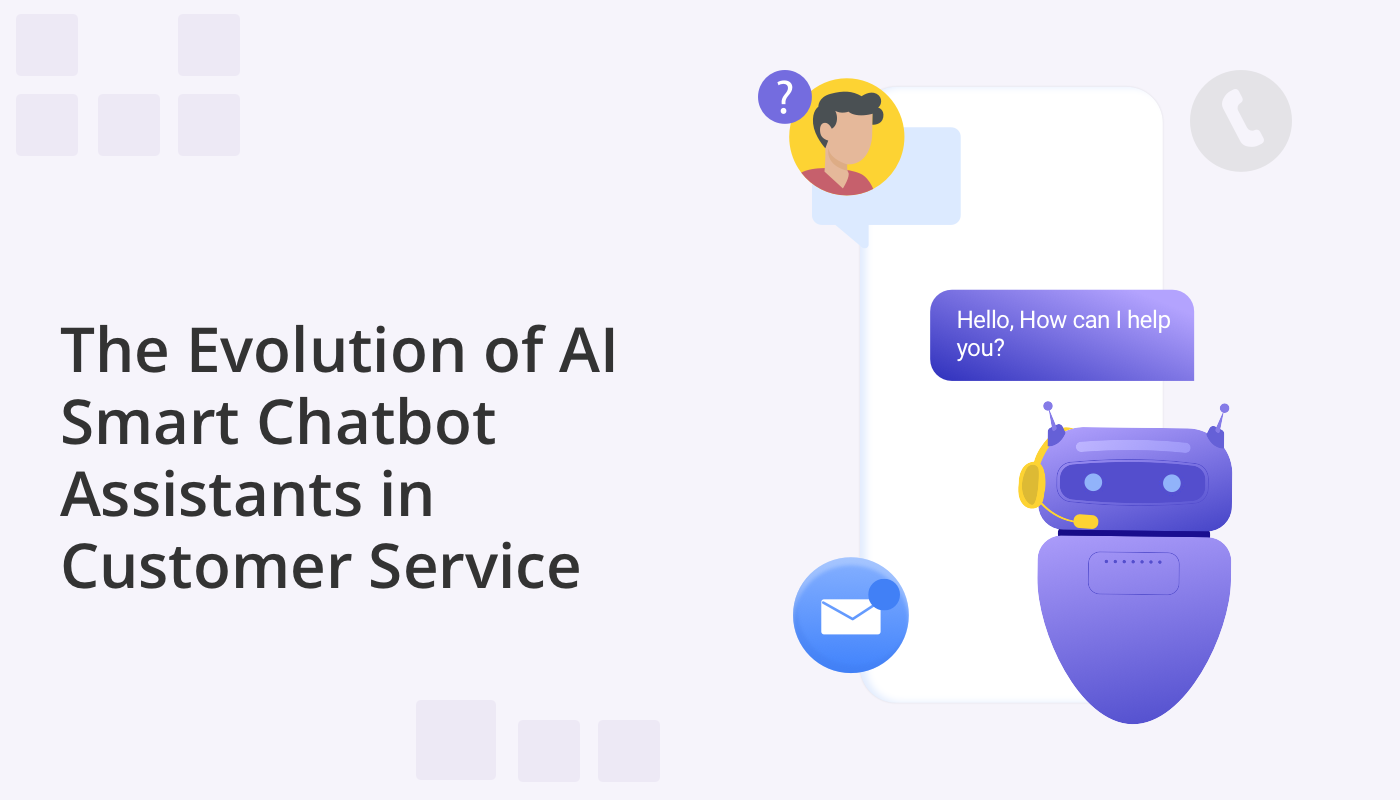
Summary: This blog explores the evolution of chatbot technology in the context of customer service. It focuses on the pivotal shift towards machine learning, emphasizing how it revolutionized chatbots into highly sophisticated, context aware entities, capable of improving. It then outlines the positive impact of the AI Smart Chatbot assistant on both operational efficiency and customer experience and briefly considers possible future developments.
Introduction
The fusion of Artificial Intelligence (AI) and customer service is not a novel concept, but recent advancements in AI technology have accelerated changes, with the AI powered chat assistant standing at the forefront of the customer service revolution. Chatbots have evolved from what were once simple rule-based systems into complex, adaptive, machine learning entities. These user-friendly tools have the power to engage customers in a conversation, understand their queries, and respond—providing instantaneous support and enriching the customer journey. An increasing number of customers use and approve of these conversational AI chatbots, with some satisfaction rates reported as high as 88%. As businesses strive to enhance user experiences and streamline communication channels, the AI smart chatbot assistant has emerged as an indispensable tool, reshaping the way companies interact with their customers. Let’s look at its evolution and what it means for customer service today.
Learn more about, Why your customer service needs live chat
The Origins of AI in Customer Service
The roots of AI in customer service can be traced back to the early days of automated communication systems. The initial attempts to integrate AI into customer interactions primarily involved rule-based systems that followed predefined scripts. These early chatbots were designed to respond to specific keywords or phrases, offering a basic level of interaction.
In the 1960s and 1970s, companies started employing basic automated phone systems to handle routine customer queries. These systems, while primitive by today’s standards, marked the first steps towards automating customer interactions. The 1990s saw the emergence of rule-based chatbots that operated on a set of predefined rules and decision trees. These chatbots could handle simple and repetitive tasks, providing scripted responses based on keyword recognition.
The early 2000s witnessed the introduction of virtual assistants, such as Clippy in Microsoft Office. Although these assistants were often criticized for their intrusiveness, they paved the way for more sophisticated AI interactions. Despite these advancements, early AI systems faced significant limitations. They struggled with understanding context, lacked personalization, and were often unable to handle complex queries.
The shift towards machine learning marked a significant turning point for the development of chatbots, transforming them from rule-based systems with limited capabilities to intelligent and adaptive conversational agents.
Introducing the AI Smart Chatbot Assistant
Primarily, an AI Smart Chatbot Assistant operates using conversational AI— a branch of AI technology that facilitates human-like conversation. To make this possible, the chatbot learns from every interaction and hones its responses over time. Picture a customer service agent who never tires, who can remember every conversation it’s had, and who’s continuously learning how to respond more effectively. That’s an AI Smart Chat Assistant.
Let’s look a little deeper to provide a fuller understanding of this new generation of AI powered chatbot assistants. It’s possible to identify 5 distinct capabilities of modern AI Assistants that make them stand out from their counterparts.
1. Ability to Train on Data: AI driven smart chat solutions leverage machine learning algorithms, allowing them to train on large datasets. This enables them to continuously learn from user interactions, improving their understanding of language, user intent, and the context over time. The ability to train on data contributes to more dynamic and adaptable chatbot behavior.
2. Ability to Understand Language: Advanced natural language processing (NLP) techniques empower smart chatbots to understand and interpret the nuances of human language. They can recognize synonyms, process complex sentences, and infer user intent, leading to more accurate and contextually relevant responses. This enhanced language understanding significantly improves the user experience.
3. Ability to Respond to Context: Modern chatbots excel in responding to context by maintaining an understanding of the conversation flow. They can reference prior messages, recognize user preferences, and adjust their responses based on the evolving context. This contextual awareness leads to more coherent and meaningful interactions, mirroring a more human-like conversation.
4. Ability to Personalize Responses: AI smart chatbot solutions can personalize responses based on user data, history, and preferences. By leveraging machine learning, they adapt to each user’s unique context, providing tailored recommendations, information, or assistance. This personalization enhances user engagement and satisfaction, fostering a more individualized experience.
5. Ability to Improve and Develop: The new generation of chatbots can continuously improve and develop autonomously. Through machine learning, they analyze user feedback, learn from new data, and refine their responses over time. This iterative learning process ensures that smart chatbot assistant platforms continue to evolve, becoming more effective, accurate, and responsive as they accumulate more interactions.
The Impact of AI Smart Chatbot Assistants on Customer Service
The AI smart chatbot assistant is shaking up the customer service landscape in more ways than one, enhancing both operational efficiency and customer experience.
The standout advantages of employing AI powered chatbot assistants are their round-the-clock availability and the capacity to handle multiple customer interactions at the same time. Traditional customer service representatives are limited by working hours and their ability to multitask. Conversely, AI smart chatbot assistants can engage with numerous customers simultaneously, resolving routine queries instantly, no matter the time of day. It’s like having an army of tireless customer service representatives at your disposal, enabling businesses to offer an uninterrupted, consistent service experience.
Moreover, with the advent of NLP technology, today’s AI smart chat assistants can understand and respond to customer queries more precisely, irrespective of languages and dialects. This enhances the level of personalized response that can be offered. In fact, the advent of this new technology has reshaped the concept of ‘personalization’ in customer service. Instead of a one-size-fits-all approach, these assistants now provide solutions and suggestions based on the individual customer’s history, preferences, and behavioral patterns. The assistant’s ability to analyze and act on this data transforms an impersonal interaction into a personal consultation, rapidly improving the user experience.
Significant time reduction in handling queries is another effective contribution made by these AI powered chat assistants. For instance, the time taken to resolve a frequently asked question (FAQ) can be immensely reduced, thanks to the quick recall and information aggregation capabilities of AI smart chatbot assistants. This swift resolution not only facilitates convenience but also improves the overall satisfaction rate among consumers. Recent studies show that chatbots are predominantly employed to address uncomplicated queries and are able to independently complete conversations (without human agent input) almost 70% of the time. The convenience of swift responses is a key factor contributing to the satisfaction, with 68% of users reporting that they appreciate the efficiency that chatbots bring to their inquiries.
Human agents are also freed up to tackle more complex, strategy-driven, and interesting tasks. No longer having to deal with repetitive and mundane inquiries consequently also leads to a better job satisfaction rate for employees, improving the overall functioning of the customer service department.
The Future of AI Smart Chatbot Assistants in Customer Service
As AI technology continues to evolve at a staggering pace, we can only just begin to imagine how the functionality and application of Smart Chatbot Assistants will advance.
The future holds the promise of AI smart chatbot assistants becoming proactive rather than merely reactive. In other words, they’ll be able to predict customer demands even before they’re expressed, answering questions the customers hadn’t even considered yet. This level of anticipation requires a high degree of understanding of consumer behavior – a possibility that is looking likely as AI and machine learning capabilities continue to improve.
The future trajectory of chatbots in customer service is also marked by a transition towards multi-modality. Rather than relying solely on text-based interactions, chatbots are evolving to engage with users through a variety of communication modes, including voice, images, and video. This multi-modal approach not only enhances the overall customer experience by catering to diverse communication preferences but also reflects the continuous evolution of chatbots as versatile tools in the realm of customer support.
Beyond enhancing the customer experience, AI smart chatbot assistants are expected to create value in ways that are currently unexplored. They may play a significant role in generating insights for business strategies, given their direct interaction with consumers and the wealth of data they can collect. With more sophisticated algorithms, these chatbots could come to analyze consumer patterns and preferences in depth, helping businesses tailor their offerings more effectively.
It’s vital to note, however, that the pace of these advancements hinges largely on data privacy regulations’ evolution. As chatbots gain more capabilities, businesses and developers alike must ensure they adhere to appropriate guidelines while handling users’ data.
Final thoughts
The advantage a smart chatbot assistant platform brings to customer support is undeniable. AI chatbots dramatically enhance responsiveness, proactively address consumer needs and in the process transform the customer-service landscape. However, it is important that you choose the right smartchat assistant for your business. Additionally, the seamless integration of these chatbots with existing services could make them an inseparable part of digital ecosystems, cultivating a new form of communication and interaction.
If you are looking to integrate a smartchat assistant into your platform, please chat with us at QuickBlox. Our no-code dashboard makes it easy to build and integrate a smartchat assistant in minutes, trained on your own company database. Furthermore smartchat assistant can be used with our video-calling or chat-only white label consultation app, especially designed with customer support in mind.
Talk to a sales expert
Learn more about our products and get your questions answered.
Contact sales






